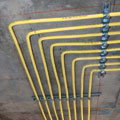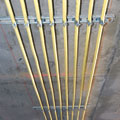
The Park Avenue Condominiums, a luxury
multi-family mid-rise in Las Vegas,
benefited from the installation of CSST. Photos courtesy of Gastite.
A luxury multifamily mid-rise building in Las Vegas was staring at a big challenge. The property consists of 20 contiguous, five-story buildings. The entire first floor of each 32-unit building is an open parking garage.
Every garage has as many as 14 different weight-bearing beams protruding from the ceiling. Gas lines had to be routed around these beams, each of which measures 20 inches deep and 48 inches wide.
The first 15 buildings in the Park Avenue complex all used black-iron pipe for gas distribution. Wrapping 1 1/4-inch and 1 1/2-inch metal pipe around the drop beams - which involves challenging threading and cutting - could have stretched gas line installation time to nine weeks per building.
For building No. 16,Interstate Plumbing & Air ConditioningProject ManagerDennis Aukermanrequested a boost in gas pressure to 5 psi to accommodate smaller pipe. He also switched to Gastite corrugated stainless-steel tubing - its flexibility sharply reduces the number of fittings needed - around the drop beams and throughout the remainder of the project.

The
CSST gas lines for the 32 units in building No. 16 were split into two groups
with a bank of 16 meters installed on either side of the garage.
The Rest of the Story
After more than 3 1/2 decades in the plumbing business, Aukerman still describes himself as an adventurous type who is “always open to new experiences. I’m not afraid to try anything new to stay on top of my trade.”Of course, it’s one thing to say you’re a “cutting-edge” kind of guy. But it’s quite another to take a job at, say, the South Pole installing and maintaining boilers at the Edmundson Scott Science Station there.
Ten years ago, Aukerman was selected by the National Science Foundation from among 1,500 other applicants for the assignment of keeping the heat flowing - a rather vital responsibility in a facility that sits atop a polar ice cap two miles thick. Aukerman and a team of 41 scientists from around the world were voluntarily stranded at the station for eight months.
Temperatures would routinely get down to -90 or -100° F with wind chills plummeting to -170° F.
“The Air Force cannot land in those temperatures because their hydraulics freeze at -56° F,” Aukerman explains. “So there we were, stuck in the dark and the cold.”
Aukerman now spends his days in balmier climes serving as the project coordinator for Interstate on several mid-rise and high-rise residential structures in Las Vegas. While a long way from the South Pole, these projects, and in particular the Park Avenue Condominiums, are the most recent expression of Aukerman’s penchant for staying “on top of my trade.”
Time To Switch
Interstate’s gas crews ran into formidable installation challenges in the aforementioned open parking garages where the gas lines had to be routed around the weight-bearing beams.The first 15 structures at Park Avenue were handled by another company. Black-iron pipe for gas distribution with 1 1/4-inch and/or 1 1/2-inch lines caused a large chunk of installation time to be spent in the garage.
Aukerman and Interstate started their work on building No. 16. Aukerman’s request that the gas pressure be boosted from approximately 1/2 psi to 5 psi permitted the use of smaller and much more installer-friendly 1/2-inch piping.
“On the first building (No. 16), we played around with different approaches and tried different techniques,” Aukerman says.

By
using CSST in building No. 16, the installer’s three-man crew needed only six
weeks to install the gas piping, a 33% savings in time.
Split System
The gas lines for the 32 units in building No. 16 were split into two groups with banks of 16 meters installed on either side of the garage. From each meter, Aukerman’s crew ran 1/2-inch Gastite lines through the garage and around the beams up to a utility room at each apartment.A regulator at that point drops the pressure to the half-pound required by most appliances. A 3/4-inch line connects the regulator to a three-outlet manifold from which 1/2-inch lines extend to a water heater, a range and a clothes dryer.
Makes Perfect Sense
In all, Interstate installed 8,250 feet of Gastite pipe in building No. 16 - most of it 1/2-inch because of the 5 psi incoming pressure.“The flexibility (of the pipe) means fewer connections,” Aukerman notes. “As a result, the pipe installed faster while drastically decreasing the chances of a leak.”
In the end, Park Avenue proved to be another example of Aukerman’s “can-do” mindset.
“I’m not afraid to try things another guy might not think of,” he says. “With all those drop beams in the garage ceiling, CSST just made perfect sense.”

Properly
bonding and grounding a CSST system may reduce the risk of damage and fire from
a lightning strike.
Lightning Safety
Aside from the convenience of using CSST, safety is always a concern, especially where lightning is frequent. Safety boils down to how each system is installed in a structure. To help maximize safety, contractors should ensure proper installation of every CSST system by following local codes and requirements and by following the CSST manufacturer’s design and installation requirements.Lightning can be a highly destructive force, and ensuring lightning safety in new and existing structures is important for customers and occupants, and for business in general. Even a nearby lightning strike that does not strike directly can cause systems in the structure to become electrically energized.
It is essential to understand all metallic systems within a structure can be affected by lightning strikes. Safety isn’t just about how each system is installed - it’s about how each installation relates to other home metallic systems. Properly bonding and grounding a CSST system may reduce the risk of damage and fire from a lightning strike.
Differences in potential between systems may cause the charge to arc between systems. Arcing can cause damage (including holes) to CSST. Bonding and grounding should reduce the risk of arcing and related damage. The building owner should confirm the CSST gas system has been properly bonded to the grounding electrode system on the premises. Gastite offers its FlashShield system that provides additional layers of resistance and eliminates the need for additional manufacturer-required bonding.
All owners should talk to a lightning safety consultant to determine whether installation of a lightning protection system would be required to achieve sufficient protection for all building components from lightning. A big factor to consider is whether the area is prone to lightning. Areas with high lightning risk include but are not limited to: Alabama, Arkansas, Florida, Georgia, Illinois, Indiana, Iowa, Kentucky, Louisiana, Maryland, Michigan, Mississippi, Missouri, New Mexico, North Carolina, Ohio, Oklahoma, Pennsylvania, South Carolina, Tennessee, Texas, Virginia and West Virginia.
One available source of information regarding areas more prone to lightning than others is the flash density map provided by the National Weather Service, which can be found atwww.lightningsafety.noaa.org. Lightning protection systems are covered by National Fire Protection Association 780, the Standard for the Installation of Lightning Protection Systems and other standards.

